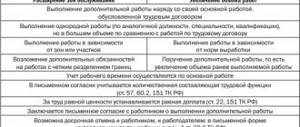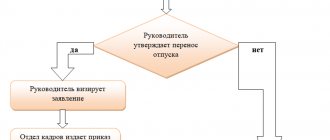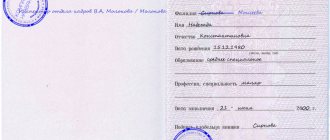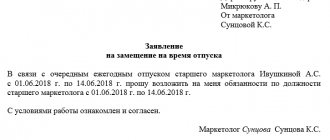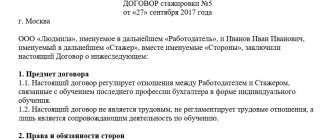Vladislav Varshavsky
Managing partner of legal
As the managing partner of the legal entity, Vladislav Varshavsky , the employee must be asked to explain the reasons for absence from work, since the employee’s right to provide explanations is provided for by law. Otherwise, the employer’s decision to dismiss a subordinate for absenteeism is recognized by the court as unfounded. As an example, the lawyer cited the ruling of the Moscow City Court dated July 30, 2018 No. 4g/7-8964/18, from which the conclusion follows: the employer did not send the employee a request for an explanation for his absence from the workplace, did not provide him with the opportunity to explain the reasons for his absence, and therefore , significantly violated the procedure for dismissal on his own initiative. On this basis, the dismissal was declared illegal, and the employer had to reinstate the employee in his position, pay him the average salary for the period of forced absence and compensate for moral damages.
If after a reasonable period of time no response is received or the letter is returned due to the expiration of its storage period, it is necessary to draw up an act of refusal to provide explanations. It will be needed to justify subsequent dismissal in court.
Sample act of refusal to provide written explanations
Sample letter with questions about the reasons for absenteeism
If an employee appears at work and does not provide supporting documents, on the same day he must be given questions about the reasons for his absence. He has two working days to write his explanation. If after this time no explanations are provided, on the third day an act of refusal to provide written explanations is drawn up. If explanations are provided, proceed to the next step.
Important conditions for recognizing absenteeism
In judicial practice, there are cases where truant workers won lawsuits due to incorrectly documented and undocumented fact of absenteeism and were reinstated at work. That is why the employer must carefully prepare all documents related to absenteeism. However, you should not do this retroactively. As practice shows, such facts are provable and the court will side with the employee who committed absenteeism.
In what cases is an employee’s absence from work regarded as absenteeism:
- If the employee is absent from the workplace during the entire work shift (even if it lasts less than 4 hours).
If the employee does not have a documented workplace and he was on the territory of the organization, the employer will not be able to give him official absenteeism. Conclusion: assign a workplace to each employee in the employment contract when he/she starts working.
- If the employee is absent from the workplace for more than 4 hours.
Moreover, if the employee was absent for exactly 4 hours, such absence will not be considered absenteeism.
- Absence from work for unexcused reasons.
The employee must confirm each absence from the workplace with supporting documents. For example, a sick leave certificate, a summons to court or for an inquiry, a certificate from a medical institution and other documents. At the same time, the employer has no right to fire a pregnant woman who has committed absenteeism.
- If the fact of absenteeism is proven.
Each absence must be documented. Otherwise, if the employee goes to court, justice will not be on the employer’s side.
What is considered truancy?
Absenteeism is absence from work. Punishment is imposed strictly in accordance with the norms of current legislation. The following actions are considered truancy:
- absence from work for more than 4 hours without a valid reason or warning;
- the person did not show up for work during the entire shift;
- the person independently assigned himself a day off without notifying the employer and without obtaining consent;
- the employee went on leave without permission without properly notifying the company;
- the citizen ignored the term of service after writing a statement of his own free will;
- the employee did not write a letter of resignation of his own free will or ignored the deadline established by the employment contract.
If a person cannot justify the failure to appear and confirm the specified reason, sanctions will be applied to the violator.
If a person has committed a violation, you should not immediately dismiss him. First you need to find out the reason.
An exception is acceptable. If a person called the boss in advance and said that he would not be able to go to work due to a valid reason, this is not considered absenteeism. However, there are a number of difficulties.
If a dispute arises, it is important to confirm that the supervisor has been notified. In this situation, the presence of witnesses to the telephone conversation or its recording will help.
Employee responsibilities may vary significantly. This feature is also taken into account. If 1 secretary does not show up, nothing bad will happen during his absence. However, when the chief engineer responsible for launching the equipment and starting production does not show up, the organization may face colossal losses.
Documentation of employee absenteeism
So, we have figured out in what cases an employee’s absence from the workplace is considered absenteeism and how to prove it. How to document an employee’s absenteeism and its consequences?
The final decision on punishing an employee for absenteeism is made by the employer himself. An employee may be held liable for absenteeism in the form of:
- Layoffs. When dismissing someone for absenteeism, you do not need to draw up 2 orders - on imposing a disciplinary sanction and terminating the employment contract. An order to terminate the employment contract is sufficient. As the basis for such an order, reports, acts, explanatory notes from the employee, time sheets, that is, documents that prove the fact of absenteeism and justify dismissal, are indicated.
- Disciplinary action. It is issued by order of the head of the institution. This order does not have a unified form, so each enterprise can develop its own sample order. You can take the unified forms of other orders as a basis, so as not to forget to indicate all the necessary details in the document. For example, an order in form T-6 to grant an employee leave.
You can order an order in form T-6 on our website “Unified form of order T-6 - and sample” .
Such an order must reflect the following points:
- the fact of violation by the employee of labor discipline, that is, absenteeism itself, indicating its date;
- documents that prove the fact of absenteeism of the employee (memos, acts, explanatory notes from the employee, time sheets);
- type of punishment (consequences of violation): reprimand, reprimand, deprivation of another bonus, etc.
On our website you can form an order for disciplinary action. See the article “Disciplinary sanction order - sample and form” .
In order to, if necessary, punish an employee for absenteeism, the employer must, upon hiring, familiarize him with his job responsibilities (employment contract, job description) and internal labor regulations against personal signature. Then, after a decision on dismissal or disciplinary action is made, if the employee goes to court, there will be a greater chance that justice will side with the employer.
Drawing up an order for disciplinary action
The order must be prepared within a month from the date of violation. The document reflects the following information:
- name of the organization publishing the paper;
- name of the document and its number;
- place and date of publication;
- the circumstances of the incident;
- decision made by the employer;
- job title of the author of the order, signature and transcript.
Punishment is a reprimand, reprimand or deprivation of a bonus. After the order is issued, the employee will not receive any incentive. The bonus will be partially or completely forfeited. The rules are valid for the prescribed period of punishment.
How to properly document absenteeism
How to properly document absenteeism
Let us consider in detail how to register absenteeism at work. First, a certificate of absence of the employee from the workplace is drawn up. It contains the following data:
- Full name and position of the absent employee;
- date and time of absence;
- date and time of drawing up the act.
Act on truancy Act on truancy
The document must be signed by 3 witnesses from among the organization’s employees. Each of them confirms with his signature that at the time of drawing up the act the violator was absent from the workplace.
The completed act is handed over to the HR specialist. Based on this document, he puts it down on the working time sheet in the form T-12 and T-13.
The employer is then obliged to wait for the employee to arrive and receive his written explanation. According to Art. 192 of the Labor Code of the Russian Federation, you cannot fire a person for absenteeism without finding out the reasons for it. Absenteeism itself can be recorded only if the employee did not have a valid reason for not showing up for work. If there was a good reason, he must describe it in an explanatory note. Absenteeism in this case will be excluded, the employee will simply return to performing his work duties.
How to write an explanatory note for absenteeism at work - read on our website in this article
How to record the fact of absenteeism
A corresponding note must be made in the work book about a reprimand or dismissal.
Video: dismissal for long absence: how to challenge, whether reinstatement is possible, other nuances
How to record absenteeism on a time sheet
It is important to understand that you do not have the right to indicate absenteeism on your time sheet until the exact reason for the employee’s absence from work has been clarified. If you do not have this information, then you must put the letters НН on your report card (this should indicate any unexplained absences).
Only after receiving official confirmation is it necessary to put the mark P (absenteeism) in place of the passes. Below is an example of such a note on a timesheet.
Example of designation in a report card for absenteeism and absenteeism
On the report card, days of absenteeism are marked with the NN symbol until the absenteeism is documented.
Step-by-step procedure for dismissal for absenteeism
The step-by-step instructions for dismissal for absenteeism provide the following procedure for going through all stages: from committing an offense - absenteeism - to the final entry in the work book.
It is important to comply with all procedural formalities to avoid litigation. After all, if the procedure for actions and paperwork is violated, the dismissal may be declared illegal in court, the employee may be reinstated in his position, and the employer may be required to pay compensation.
So the procedure for how to properly fire an employee for absenteeism:
- Document the fact of absenteeism. This can be done by drawing up an employee absence certificate. The act is drawn up in the presence of witnesses (2-3 people). It is also permissible if the immediate supervisor submits a report on the commission of an offense to his subordinates to higher authorities.
- Request clarification from the employee. An explanatory note must be drawn up only in writing. Verbal explanations are not suitable. Duration – 2 days.
- Based on the results, either the official investigation is closed or a report is drawn up. Also, if there are no explanations from the employee within 2 days, a corresponding act is drawn up (Article 193 of the Labor Code of the Russian Federation).
- A decision is made to impose penalties. The right to fire for absenteeism is not an obligation, that is, the employer may not fire the employee, but apply another type of penalty.
- A dismissal order is being prepared.
- Familiarize the employee with the order.
- Record your dismissal by making an entry in your work book.
Nuances of action during long absences
The situation when there is a long walk deserves special attention. When dismissing someone for long absence, the step-by-step instructions are almost the same as for normal dismissal, that is, there are discrepancies:
- Record absence: draw up an act, enter data into the working time sheet.
- Draw up a notice of the need to appear and provide explanations.
- Send notice to the employee at a known postal address.
- After receiving notification of delivery, wait 2 days + the period required for delivery of correspondence.
- If explanations are not provided and confirmation of receipt of the notification, draw up a report.
- Take measures to determine the reasons for absence if notification has not been received. This stage is not mandatory, but recommended to avoid problems in a possible lawsuit later. You can make calls to the employee’s relatives and get their testimony.
- Draw up a report on the activities carried out, recording the information received. Optional.
- Issue a dismissal order.
- Draw up a report on the impossibility of familiarizing the employee with the order.
- Enter information into the work book.
- Make payment calculations.
- Send a notification to the employee about the need to obtain a work book.
Due to the fact that the law establishes a period for disciplinary punishment of 1 month, it is necessary to carry out all actions as quickly as possible. Considering that letters are returned to the sender after a month of storage, we recommend sending a telegram asking for clarification.
It would also be reasonable to draw up daily reports of the employee’s absence during the entire period of absenteeism, or to record this in another accessible way, for example, by making notes in the arrival and departure log, in order to comply with the procedure for dismissal for absenteeism without a good reason.
Preparation of procedural papers
The first document that needs to be prepared is confirmation of the fact of absence. The most common option is to draw up a report, although a report can also be used, based on the results of which an official investigation is opened. After requesting an explanatory note, you must wait two working days. Immediately on the day of absenteeism, it is impossible to issue a dismissal order for absenteeism sample and terminate the employment contract.
As part of the investigation, a decision may be made to dismiss for absenteeism without a valid reason if the employee refuses to provide an explanation for why he was absent. Or he did not confirm the documented reason, even if he considers it valid. An act should be drawn up about this.
You can download a sample act of dismissal for absenteeism by clicking on the link.
Requesting an explanation personally from an employee can sometimes be problematic. For example, if the employee never came to work. In this case, it is necessary to notify the employee of dismissal for absenteeism (sample) in case of refusal to provide explanations for his actions. Notification is sent via mail. You can notify by registered mail or telegram. The two-day period must be counted from the date of receipt of the notification by the employee.
After completing the investigation and establishing the reason for the absence, or if an explanation was never given by the employee, a decision is made to apply a penalty. The result is an order for the employee to take absenteeism (for 2021) and apply a disciplinary measure. If management decides to fire an employee, then there is no need to issue two separate orders - for dismissal and for discipline. One thing is enough - a sample. The employee must be familiarized with the order within 3 days. If you refuse to familiarize yourself, you must draw up a corresponding act.
Compliance with time periods
In addition to collecting and completing the necessary documents, it is important to meet the deadlines for specific events. The period during which a penalty can be applied is a month from the date of the offense. That is, you cannot fire someone for absenteeism after a year. However, in a number of cases, the course of the period is interrupted due to circumstances beyond the control of the parties. This could be: illness or vacation of an employee, during which it is impossible to dismiss. But the maximum extension period established by law is 6 months (Article 193 of the Labor Code of the Russian Federation).
date of dismissal
If there is a dismissal for absenteeism, then on what day should the dismissal take place? Not an easy question. To make a decision, you must be guided by Art. 84.1 Labor Code of the Russian Federation. According to its contents, the employee’s last working day is the date of his dismissal, if for other reasons there is no place assigned to him. In the case of absenteeism, the last day that the employee worked was the day before the day of absenteeism, unless a valid reason was confirmed.
Therefore, if the absenteeism was a one-time occurrence and the employee subsequently appeared and gave explanations that were regarded as an unjustifiable reason, the date of dismissal and the order to dismiss for absenteeism will correspond to the day the explanatory note was received. if the absenteeism is of a long nature, the employee’s daily absences are confirmed by reports and time sheets, and explanations were never received, then dismissal is allowed on the last working day. However, dismissal dated on the day of drawing up the final act of lack of explanation will not be a violation.
Registration of a work book
Entering data into the work book is the final stage of dismissal. If you don’t know or are not sure under what article one is fired for absenteeism, then dismissal for absenteeism is regulated by Article 81 of the Labor Code of the Russian Federation. Information is entered into the employee’s work book based on the order. The registration data of the order itself is written in the column “Name and date of the document.” Sample entry in the employment record about dismissal for absenteeism:
First, the number of the serial entry is indicated; the deadline is not missed. Next, the date for entering the information is specified, which must coincide with the date of dismissal and issuance of the order. Next, the dismissal for absenteeism is indicated in words in the labor record (Article 81 of the Labor Code of the Russian Federation). Afterwards the signature and title of the position of the responsible person are affixed. The record is certified by the company seal.
Sometimes an employer can terminate a contract and fire not for absenteeism, but if the employee is recognized as dead or missing. To do this, it is necessary to have a court decision (here details about the procedure for filing an application to the court) confirming this fact. The employer can initiate the process himself, or another interested party, for example, a relative, will file a claim.
The entry in the work book will look like this:
An employee did not show up for work: 5 actions of a personnel officer
What can be considered absenteeism?
Absence from work means an employee’s presence during working hours outside the territory of the enterprise or outside the territory of the facility where he must perform assigned work, without good reason.
In accordance with Part 3 of Clause 37 of the Resolution of the Plenum of the Supreme Court of the Republic of Uzbekistan dated April 17, 1998 No. 12 “On the application by courts of legislation governing the termination of an employment agreement (contract)”, absenteeism for the period determined by the Internal Labor Regulations (ILR ) enterprises can also be considered:
- unauthorized, without the permission of the employer, going on vacation or unauthorized use of days off;
- abandonment of work without warning the employer, as well as before the expiration of a two-week or other period of notice reduced by agreement of the parties to the employer about termination of the employment contract at the initiative of the employee;
- leaving work before the end of the notice period established by law or reduced by agreement of the parties regarding termination of the employment contract at the initiative of the employer, etc.
The concept of absenteeism and its duration must be precisely formulated and included in the List of one-time gross violations of labor duties of the Internal Labor Regulations (ILR) of the enterprise.
Valid reasons for absenteeism:
The labor legislation of the Republic of Uzbekistan does not establish a list of valid reasons for absence from work. This issue is resolved in each specific case by the employer, and if disagreements arise, by the court.
The fact of absenteeism is proven by the employer, which is confirmed by the act of absence of the employee from the workplace and the work time sheet.
The employee must prove that the reasons for absence from work are valid. This can be confirmed by relevant documents (for example, a certificate of temporary incapacity for work, a summons to court, the prosecutor's office, a certificate of transport disruption, etc.), as well as witness testimony.
Disciplinary sanctions for absenteeism (Article 181 of the Labor Code of the Republic of Uzbekistan):
For absenteeism, the employer has the right to apply the following disciplinary measures to the employee:
1) reprimand;
2) a fine in the amount of no more than 30% of the average monthly earnings (no more than 50% of the average monthly earnings, if such cases are provided for by the internal labor regulations of the enterprise);
3) termination of the employment contract (clauses 3 and 4, part 2, article 100 of the Labor Code of the Republic of Uzbekistan).
Conditions for imposing a disciplinary sanction on an employee for absenteeism, up to and including termination of the employment contract:
Imposing a disciplinary sanction on an employee for absenteeism is possible if the following conditions are simultaneously met:
- if the deadlines for imposing disciplinary sanctions are met, a disciplinary sanction is applied immediately upon discovery of absenteeism, but no later than one month from the date of its discovery, not counting the time the employee is ill or on vacation;
- if the enterprise has Internal Labor Regulations (ILR), approved by the employer in agreement with the representative body of workers and containing a List of one-time gross violations of labor duties, precisely defining the concept of “Absenteeism” and its duration;
- if there is appropriate confirmation of the employee’s timely familiarization with the PVTR and the List of one-time gross violations of the enterprise’s labor duties;
- if the employee’s absence from work for an unexcused reason is proven in the prescribed form;
- if the termination of the employment contract is made taking into account the severity of the offense, the circumstances under which it was committed, the employee’s previous behavior and his attitude to work (part two of Article 184 of the Labor Code of the Republic of Uzbekistan).
What to remember when terminating an employment contract for absenteeism:
- An employment contract cannot be terminated with pregnant women and women with children under three years of age (Article 237 of the Labor Code of the Republic of Uzbekistan);
- Termination of an employment contract with employees under eighteen years of age is permitted with the consent of the local labor authority (Article 246 of the Labor Code of the Republic of Uzbekistan);
- When terminating an employment contract with graduates of secondary special, vocational educational institutions, as well as higher educational institutions, who studied on state grants, who entered work for the first time within three years from the date of graduation from the relevant educational institution, before the expiration of the three-year period from the date of conclusion of the employment contract, the employer must notify the local labor authority about this (Article 2471 of the Labor Code of the Republic of Uzbekistan);
- It is not allowed to terminate an employment contract with an employee during the period of his temporary disability and while the employee is on vacation (Part 2 of Article 100 of the Labor Code);
- The employer must notify the employee at least three days in advance of the termination of the employment relationship with him or pay him adequate compensation (Article 102 of the Labor Code of the Republic of Uzbekistan).
ALGORITHM FOR FORMULATING TERMINATION OF AN EMPLOYMENT CONTRACT FOR ABSOLUTELY:
Step 1. Establish the fact of absenteeism:
Current legislation does not provide for any procedure or list of documents that must be drawn up to establish the fact of absenteeism of an employee. According to established practice, documents confirming the fact that an employee is absent from the workplace include:
- memo (report) from the employee’s supervisor;
- certificate of absence of the employee from the workplace;
- time sheet.
Step 2. We find out the reasons for the employee’s absence from work and demand a written explanation from him:
Before applying a disciplinary sanction, the employer is obliged to request a written explanation from the employee (Part 2 of Article 182 of the Labor Code of the Republic of Uzbekistan). If the employee refuses to give an explanation for absenteeism, an act of refusal to give an explanation by the employee is drawn up.
If an employee does not show up to the workplace after absenteeism, letters (with notification) are sent to his registration and actual residence addresses (if they are different) with a requirement to appear to give an explanation for the fact of absenteeism. If the employee, despite a registered letter notifying him of the need to give an explanation, does not show up and does not provide an explanation for the fact of absenteeism, the employer draws up a corresponding report on the employee’s failure to appear to give an explanation.
An employee’s refusal to provide an explanation cannot serve as an obstacle to the application of a penalty for a previously committed offense.
Step 3. We notify the employee about the termination of the employment relationship with him:
In accordance with Art. 102 of the Labor Code of the Republic of Uzbekistan, we notify the employee at least three days in advance of the termination of employment relations with him. If the employer decides to pay the employee proportionate compensation, then the corresponding clause is included in the order to terminate the employment contract with the employee.
Step 4. We issue an order to terminate the employment contract:
We formalize the termination of the employment contract by order indicating all the circumstances under which the employee was absent. We announce the order to the employee against his signature. If the employee refuses to familiarize himself with the order, we draw up a corresponding act against his signature.
Step 5. We make an entry about the termination of the employment contract in the work book and the employee’s personal card:
An entry on the termination of an employment contract in the employee’s work book is made in accordance with the “Instruction on the procedure for maintaining work books” No. 402 dated January 29, 1998. The employer is obliged to familiarize each entry made in the work book to its owner under the signature of a personal card (form T-2), in which an entry corresponding to the entry in the work book is also made.
Upon receipt of the work record book, the employee also signs in the work record book, indicating the date in his own hand.
The fact of the employee’s refusal to receive a copy of the order and work record book is documented in an act indicating the witnesses present.
If the employee is absent at the time of termination of the employment contract with him, a notice is sent to him with a requirement to appear for a work book. If the employee, despite a registered letter notifying him of the need to obtain a work book, does not show up for it and does not express a desire to send it by mail, the employer is not responsible for the delay in issuing the work book.
SAMPLES OF DOCUMENTS:
Warning about termination of an employment contract at the initiative of the employer
Documenting Disciplinary Actions
Leave a comment Office work Personnel office work Personnel records Personnel Order Absenteeism Workplace Employee Personnel management Management of subordinates Facts
Long absence - how to properly arrange it?
Long absence means missing several days of work. This violation belongs to the category of the most serious. Therefore, when absent for a long time, limiting yourself to issuing a reprimand is not enough. As a rule, the manager makes the decision to fire an employee.
It should be said that the procedure for registering this violation is the same as for simply missing a day of work. But since we are talking about dismissal, such a decision must be balanced and completely accurate. To impose a punishment, you should find out about the arguments of the employee who committed the violation and carefully check these arguments.
In addition, it is necessary to compare the violation with the job description. Another significant point is the need to record the absence of each working day. Accordingly, a report should be issued every day during the entire long absence. Explanations should be taken daily from the colleagues of the guilty person.
But the result of a long-term violation will still be an order to dismiss the person.
Article 81 of the Labor Code of the Russian Federation in 2021
In Art. 81 of the Labor Code of the Russian Federation, namely sub. “a” clause 6 states that in case of absenteeism, the employer can legally dismiss the employee. In this case, the conditions mentioned earlier must be met.
But should a manager always fire an employee for absenteeism? This article gives him the right to do this, but does not establish such an obligation. Legislators leave the right of choice to the company's management. It can reprimand the employee, reprimand him or simply leave absenteeism unattended.
In some cases, the dismissal of an employee is possible due to him going on unauthorized leave without warning management. Every enterprise must have an annual vacation schedule. It is brought to the attention of employees. Lack of a schedule is considered a violation of labor laws.
Find out how to properly create a vacation schedule and download the form on our website. Read the article “Vacation schedule - form and sample for filling out in 2021.”
But in any case, going on vacation without the approval of management is a violation of labor discipline, and the employee may be held accountable for absenteeism.
You may also find these articles useful:
- “How to properly arrange leave followed by dismissal?”;
- “Order for annual paid leave - sample and form.”
Sometimes it happens that absenteeism ends the employee’s desire to resign of his own free will. The employee writes a letter of resignation and, without working for 2 weeks, does not go to work at the scheduled time.
If an employer dismisses an employee for absenteeism, he makes a corresponding note in his work book with reference to Art. 81 Labor Code of the Russian Federation.
Concept
The Labor Code of the Russian Federation regulates such violation by a citizen of his work duties as absenteeism.
According to the terms of paragraph “a” of Part 6 of Art. 81 of the Labor Code of the Russian Federation, absenteeism is not a citizen being in his place without good reason.
Labor Code of the Russian Federation
Truancy is considered:
- the fact of absence during the entire working day (no matter how long it lasts);
- the fact of absence for more than four hours in a row in one working day.
The Labor Code of the Russian Federation regulates the legal status of absenteeism - this is a gross violation of work duties.
Note! According to the law, the employer has the right to cancel the employment relationship with the employee even with a single absence!
Conditions for recognition of absenteeism
Conditions for recognition of absenteeism
In judicial practice, there are cases when the reason for challenging dismissal and reinstatement is incorrect registration of the fact of absenteeism. Absence from work is not always a violation of discipline. Failure to appear is regarded as absenteeism only if the following conditions are met:
- The employee is absent from the workplace for more than 4 hours. If an employee has been absent for exactly 4 hours, it will not be possible to give him absenteeism.
- The absence of an employee from his workplace throughout the entire work shift, even if its duration is less than 4 hours. If a person is not assigned a workplace and he was actually on the territory of the enterprise, this will not be considered absenteeism.
- Absence of a valid reason for absence from work. If there is such a reason, you need to confirm it with an supporting document - a sick leave certificate, a court summons, a certificate from a doctor.
- Proven fact of absenteeism. The employer is obliged to document this violation of discipline, obtain the signatures of witnesses, indicate the exact time and date, and describe the circumstances in detail. If there was an incorrect registration of the employee’s absenteeism, the court will side with him.
There are cases when security does not allow an employee to enter the workplace by order of his superiors. This is usually not indicated in the act. In court, the employee will be able to defend his case by providing testimony and recordings from CCTV cameras. If the act does not indicate the exact time of absence, this will also become the basis for reinstatement at work through the court. The employee will be able to refer to the fact that the document was prepared in the evening, and he was at work in the morning.
What is considered truancy by law?
According to paragraphs. “a” clause 6 of Article 81 of the Labor Code of the Russian Federation, absenteeism is the absence of an employee from the workplace without good reason during the entire working day (shift) or for more than 4 hours in a row. Such a violation gives the employer a reason to terminate the employment contract unilaterally. However, the law does not explain what exactly is considered a valid reason. This issue remains at the discretion of the employer. Employers often recognize the following reasons as valid:
- death of a person close to the employee;
- illness of a relative;
- road accident;
- sudden acute problems of a communal nature (flooding, fire, etc.) and others.
However, such incidents must be documented (sick leave, certificate from the traffic police, Ministry of Emergency Situations, etc.).
If the employee verbally warned the employer about his absence in advance (and there are witnesses to this), it will not be possible to register absenteeism. This nuance, as well as incorrect or untimely registration of absenteeism by the employer, is taken advantage of by unscrupulous employees who, through the courts, are reinstated at work after dismissal. Therefore, the question of how to properly document absenteeism is very relevant for employers who do not want to pay from their budget for other people’s “rest” days.
When you can’t fire someone for absenteeism
According to the instructions of the Labor legislation and materials taken from judicial practice, valid reasons for absenteeism include:
- temporary disability of the employee;
- public duties assigned to the employee by state and municipal authorities;
- medical examination in health care institutions;
- arrest of an employee by police;
- transport delays due to abnormal weather conditions;
- notifying the employer in writing of his decision not to go to work due to late payment of wages;
- acceptance of employee participation in legitimate strikes.
But the above reasons must be confirmed with official papers, for example, providing a sick leave certificate issued by a medical institution, a summons for detention.
The employer must find out the reason before making a decision to dismiss. If an employee has submitted a false document, he is subject to dismissal, despite the measures taken. Payments upon dismissal for absenteeism are discussed in the article: dismissal for absenteeism.
How to write a letter of resignation by agreement of the parties with payment of compensation is described in the link.
Valid reasons for absenteeism
The legislator for the current 2021 does not define in any article of the Labor Code what are valid reasons for absenteeism. It is believed that this fact must be established within the framework of the proceedings, that is, separately in each individual case. In practice, a valid reason is one that arose not at the will of the employee.
That is, they recognize as respectful:
- employee illness;
- illness (death) of a close relative;
- emergencies;
- road accidents or incidents;
- housing and communal accidents;
- other.
Of course, valid reasons for absenteeism must be documented or otherwise confirmed, for example, by testimony of witnesses. Documents must be certified in accordance with the general procedure. For example, get a medical certificate, a copy of the accident report.
The law also does not consider absence of an employee with the consent of the manager as absenteeism. That is, if an employee “asked for time off,” then this is not absenteeism. But, as with other reasons, the fact of management’s permission must be proven.
Oral permission alone is not enough, because it will be impossible to prove it. In practice, the employer can take advantage of this “loophole”. Therefore, it is important to know what constitutes absenteeism without a good reason, absence from the workplace even with the permission of the manager, if there is no written confirmation of permission.
Is it possible to fire someone for absence from work?
The term “absenteeism”, according to the instructions of Article 81 of the Labor Code, means absenteeism, the absence of an employee from his workplace in a row without a good reason for 4 hours or completely during the working day.
However, it does not contain wording regarding a valid reason for which an employee’s absence from his workplace can be justified, as a result of which conflict situations often arise.
Dismissal of an employee for absenteeism is one of the types of disciplinary sanctions, which is formalized taking into account the general requirements of legislative acts on dismissals related to disciplinary sanctions requirements.
From the point of view of theory, it is no one other than the employer who establishes and proves the disrespect of the reason for absence. But he must act in accordance with legal acts, without relying on personal beliefs.
According to generally accepted rules, absenteeism is divided into:
- short-term absence, when the employee’s whereabouts are known and contact can be established;
- prolonged absence, the whereabouts of the employee are unknown, there is no way to contact him.
If the employee’s absence does not last long, then the person responsible for recording working hours draws up an act of the employee’s absence from the workplace, and on its basis a memorandum addressed to management.
The employee must submit, within two working days, an explanatory note in accordance with Article 193 of the Labor Code, explaining his actions.
If he did not write a note with explanations, then an act of failure to provide an explanatory note is drawn up due to his refusal.
The act is signed by the employee and three witnesses. The management issues an order, the content of which indicates the measure of influence in the form of a disciplinary sanction. Fr. is entered in the working time sheet.
In practice, there are often cases when a dissatisfied employee files a claim with a judicial authority.
If he is able to prove that he is right, then the employer is obliged to reinstate him to work. Moreover, the employer’s violation of the procedural order will also serve as a pretext for canceling the order to dismiss the employee. For example, incorrect execution of an act of absenteeism.
The dismissal procedure is regarded as not contrary to legal acts and has a legal basis if certain conditions are met. These include:
- the employee did not appear at the workplace for a full working day or for more than 4 hours;
- the employee was not at his workplace while at the enterprise;
- the reason for the employee’s absence is considered disrespectful;
- the absence of the employee is proven by documented facts.
Moreover, the time of absence must be exactly 4 hours, and he must have an officially assigned workplace at the enterprise.
The reason for absence cannot be considered disrespectful if the employee has objective reasons due to which he was unable to warn management in a timely manner.
How to properly fire someone for absenteeism
How to properly fire someone for absenteeism
If absenteeism is documented in accordance with all the rules, it is established that the employee did not have valid reasons for absenteeism, the employer has the right to apply disciplinary action. In order to properly dismiss an employee, you must strictly adhere to the procedure for dismissal for absenteeism in accordance with the law:
- Draw up a report on the employee’s absence from the workplace and familiarize the employee with it.
- Get an explanation from the truant.
- Issue and sign a dismissal order and give it to the employee for review.
- On the last day of work, issue a work book to the dismissed person and make a payment.
Did you know? An employer has the right to fire an employee for absenteeism (without a good reason) for even one day. You can read more in this article
The Labor Code allows an employee to formalize absenteeism with dismissal within 6 months from the date of recording the violation. In the event of a long absence, the dismissal order is issued not on the first day of absence, but on the date when the document was actually prepared. The day of dismissal in this case will be the person’s final day of work in the organization - when he appears in the organization and writes an explanatory note. In other cases, the day of dismissal will be considered the date that preceded the first day of absenteeism.
According to Art. 193 of the Labor Code of the Russian Federation, from the moment absenteeism is discovered, the employer will have 1 month to issue a dismissal order. In the event of a long absence, this period is calculated separately for each day of absence. If the first absence was committed more than a month ago, the employer will no longer be able to fire the employee - the one-month deadline for issuing the order has expired.
Responsibility for absenteeism in various situations
Now let's figure out how to properly fire someone for absenteeism in more specific cases. For different categories of workers, the procedure will have its own characteristics.
Combination of positions
Art. 60.2 of the Labor Code of the Russian Federation states that when combining positions, there will be no absenteeism if the employee sends a written notice to management of his refusal to perform additional work within 3 days.
Part-timers
Dismissal of a part-time worker at the initiative of the employer is possible only for the only reason specified in Art. 288 Labor Code of the Russian Federation. This is hiring another employee for whom this work will become the main one. The conclusion suggests itself: management has the right to formalize absenteeism for a part-time employee according to the general rules.
Pregnant workers
According to Art. 261 of the Labor Code of the Russian Federation, the employer does not have the right to dismiss pregnant employees at will. There is only 1 exception - liquidation of a legal entity (termination of the activities of an individual entrepreneur).
General Directors
In ch. 43 of the Labor Code of the Russian Federation there are no direct instructions about the possibility or impossibility of dismissing a manager for absenteeism. This should happen on a general basis, but the procedure is carried out by the highest collegial body (if there is one).
Young professionals
Absenteeism of a young specialist is documented according to the general rules, since Art. 336 no other instructions.
Civil servants
Civil servants are fully subject to all provisions of the Labor Code of the Russian Federation, including those related to absenteeism.
By the way, did you know that the procedure for hiring a civil servant after dismissal differs from other categories of employees? Read more in this article https://otdelkadrov.online/3289-pravila-obrazets-uvedomleniya-o-prieme-na-rabotu-byvshego-gossluzhashhego
Showing up to work drunk
Being drunk at work is not absenteeism. This is a gross violation of the labor regulations specified in Art. 81 Labor Code of the Russian Federation.
Shift work
If the work schedule is shift work, then absence from work for more than 4 hours is still recognized as absenteeism. Another absenteeism is a person’s absence from work during the entire shift, even if it lasts less than 4 hours.
Long absence (several days)
When working under an open-ended contract, an employee faces the same disciplinary measures for long-term absenteeism as for a one-time absence. Read about the possible consequences of absenteeism at work here.
How to correctly issue a reprimand for absenteeism - sample
Absenteeism is an established absence from work for three or more hours of a work day. But in order for disciplinary liability to occur for such a violation, absence during the working day must be properly documented. Only if absenteeism is properly documented, is it possible to issue an order to reprimand the employee. The procedure for recording the fact of missing a day and holding an employee accountable, including his dismissal, is as follows:
- First, the problem must be identified. As a rule, this becomes known to one of the middle managers - the foreman, the foreman, the head of the department. When missing a day of work becomes obvious, such a manager should draw up a memo. This is an internal document that documents the identification of the fact of employee absenteeism;
- The memo is submitted to senior management. This must be done on the day the missed work day is established. Then management organizes an inspection of this fact to determine whether the missed work day is valid or not. For these purposes, explanations should be obtained from the colleagues of the offending employee and from himself;
- If the results of the internal audit confirm absence during the day, the employer will decide what measures to take. From the point of view of labor legislation, absenteeism is a gross violation. In its severity, it is comparable to going out while intoxicated. Therefore, the employer has every right to both reprimand and dismiss the employee.
In this case, the management’s decision on a specific measure of responsibility of a person in the form of dismissal or reprimand is formalized by order.
order of reprimand for absenteeism
How to document absenteeism?
Such violations should be recorded in accordance with the requirements of the law and internal regulations. If the rules and regulations are violated, the order can be challenged by the employee and canceled through legal proceedings. At the same time, you should indicate several documents that must be completed when recording the fact of missing a day of work:
- The initial document will be a memorandum. In fact, this is a message about missing a day of work, which sets the stage for further internal verification;
- Conclusion of the internal audit. It is the conclusions of such a conclusion that become the basis for the order of reprimand or dismissal. The conclusion must be accompanied by the received explanations from employees, regulations on the daily routine and other necessary documents;
- Order of reprimand or dismissal. This is the final document that formalizes the management decision made based on the results of the internal audit.
All specified documents must have references to the law. Another basic condition is the validity of the punishment. The order must be reasoned and based on a reliable fact of violation. If an employee has a valid reason for missing a day of work and has submitted the relevant documents, they are not allowed to be ignored.
How to prove employee absenteeism
The main difficulty in documenting an employee’s absenteeism is to prove that the reason for his absence from the workplace is not valid. In some cases, an employee cannot notify the manager of his absence from work for objective reasons. For example, there was an emergency on the road, an employee was unexpectedly hospitalized in intensive care, etc.
IMPORTANT! There is no need to immediately prepare an order for dismissal or disciplinary action on the day of absenteeism. The main thing is to record the fact of a person’s absence from his workplace in the presence of several witnesses.
To do this, the HR department must draw up an employee absence report in any form on company letterhead. It is signed by witnesses who can confirm the situation. In addition, the act should indicate the place of preparation, the date and necessarily the exact time, the full name of the employee who compiled this document, as well as witnesses.
After the report is drawn up and before the reasons for the potential absentee’s absence from the workplace (if any) are clarified, o (failure to appear for unknown reasons) is entered in the work time sheet in form T-12 and T-13. In the future, if the employee submits supporting documents, he will be corrected, for example, to “B” (sick leave). If the employee does not have such documents, “PR” (absenteeism) is indicated.
On our website you can find out the procedure for filling out time sheets, as well as download their forms. See articles:
- “Unified form T-12 - form and sample”;
- “Unified form T-13 - form and sample.”
When an employee appears at the workplace, he must be required to provide an explanatory note in writing about the reasons for absenteeism (in the absence of supporting documents). There are known cases where an employee fired for absenteeism filed a lawsuit against his employer for illegal dismissal and won the lawsuit.
Why can dismissal be considered illegal if the fact of absenteeism has been proven? The employee may refer to the last paragraph of Art. 192 of the Labor Code of the Russian Federation and the fact that the employer did not even inquire about the reasons for absenteeism and did not assess the severity of the offense and the circumstances of its commission.
IMPORTANT! In case of absenteeism, be sure to require a written explanation from the employee.
But there are cases when employees refuse to give an explanation of the reasons for absenteeism in writing. Then the employer should issue the employee, against signature, a notice of the need to provide an explanatory note. The document must indicate the number of days during which the employee must explain his absence. This is 2 working days (Article 193 of the Labor Code of the Russian Federation).
If the employee refused to receive the notice or did not provide an explanation after the specified time, this should also be recorded in an act in the presence of witnesses.
Drawing up a truancy report
The employer must be prepared to defend its case in court. Therefore, it is in his interests to prepare the maximum documentary substantiation of his innocence - to draw up an act of absenteeism.
Purposes and conditions of compilation
The main purpose of this document is to record the fact of a violation, that is, a person’s absence from work. The paper is compiled in free form under the following conditions:
- The presence of the fact that the employee did not attend the workplace.
- The person is absent for the entire shift or for at least 4 hours in a row.
- The presence of witnesses confirming the absence of a colleague.
It is important to know! There is no mandatory requirement to record the fact on the day it occurred, since an employee can say over the phone that he is sick, but in fact, when going to work, does not provide sick leave.
Person executing the deed
An employee’s absenteeism report is drawn up by a commission. It consists of the following officials:
- employee of the enterprise personnel service;
- the truant's immediate supervisor;
- one or more colleagues of an employee who did not show up for work.
Filling out the act is carried out by a personnel officer due to detailed knowledge of regulatory legal acts in the field of labor law. The remaining persons put their signatures as confirmation of the fact of absenteeism as a phenomenon that negatively affects the work of the enterprise.
Contents of the document and procedure for execution
The document is drawn up in the presence of several people so that each of them can make sure that the colleague is really not at work. The act of absenteeism is written on the day the citizen is absent or on the first day after the person appears on the territory of the company (enterprise).
The first part of the form (there is no unified form) states the following:
- document's name;
- account serial number;
- Date of preparation.
In the main part, information such as full name and job title (you can download the form from the Internet) of the following persons must be written:
- Compiler of the document.
- Persons who are witnesses to the situation and will sign the document as confirmation of absenteeism.
- The culprit himself, whose behavior became the reason for drawing up a truancy report.
After this, it is important to enter the following information in the document:
- The date when the person was not at work.
- Hours during which, according to colleagues, the citizen was definitely not on the territory of the institution.
It is important to know! When a citizen appears after absenteeism, he is given a document drawn up in two copies. One copy remains at the enterprise (the employee writes “Acquainted”, signs, and dates it), and the second copy is taken by the absentee.
Compilation deadlines
There are several important points. The document is drawn up without delay and handed to the person (if he appears) immediately. The maximum period for creating an act is 1 month from the date of discovery of the fact. During this time period, the immediate superiors and administration of the enterprise will already know exactly the reason for absenteeism and will evaluate the level of respect for it. Post-date writing is not permitted.
Dismissal for failure to appear is permitted by law within 6 months after this fact in case of failure to provide documents confirming the valid reason for absence. More detailed information can be found in the Consultant Plus database.
Sample document
The above example can be used when drawing up acts without fear that the document will be written incorrectly.




